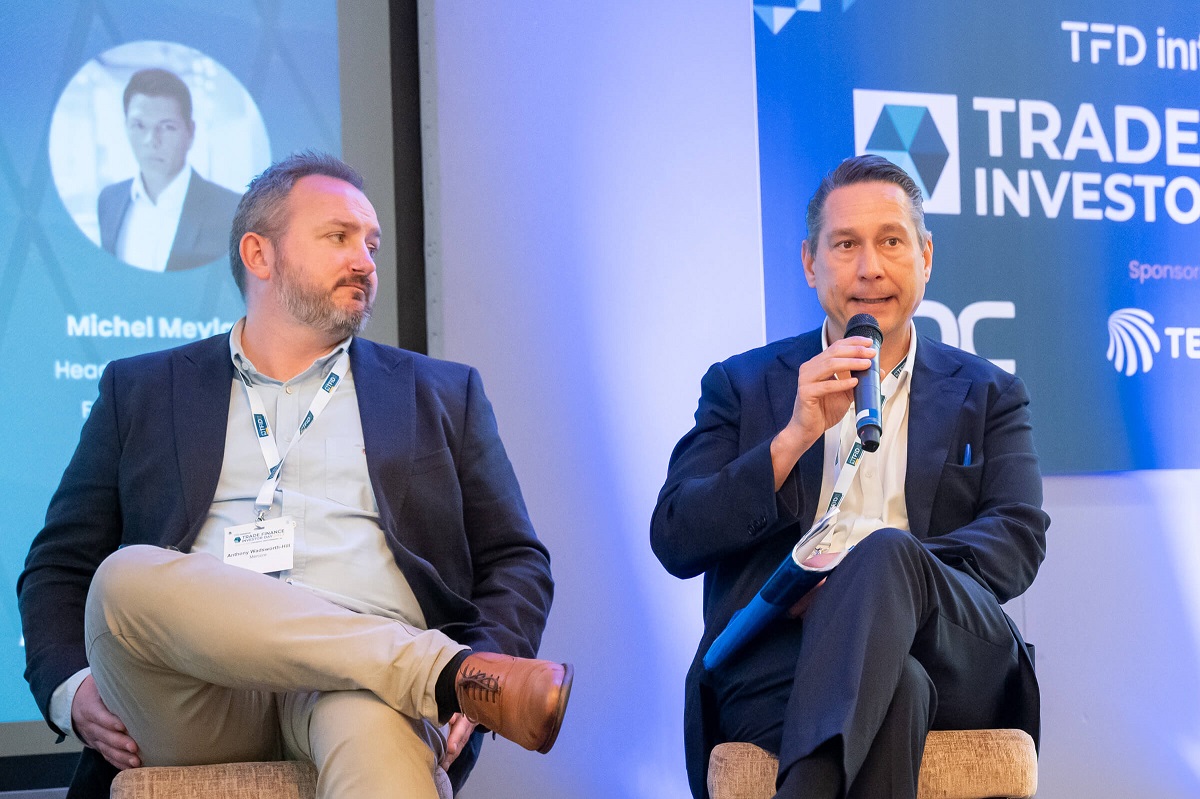20 December 2023
With lockdown restrictions lifted and trade volumes recovering, the gap between demand for and supply of trade finance continues to grow. flow’s Clarissa Dann explores how further engagement with capital market players could help bridge this
MINUTES min read
Trade has rebounded strongly in the post-pandemic world, with global goods exports growing by 26.6% and 11.5% in 2021 and 2022, respectively.1 While on the back of this recovery demand for trade finance continues to grow, the macroeconomic backdrop of recent years – characterised by higher interest rates, persistent inflation and conflicts in Europe, Russia/Ukraine and the Middle East – is limiting banks’ capacity to provide trade financing. The result is that demand is not being met by the financing available.
This restriction has had a significant knock-on effect on the ‘trade finance gap’, which is the difference between requests and approvals for financing to support imports and exports. According to the Asian Development Bank (ADB) research report published in September 2023, the gap grew to a record US$2.5trn in 2022 – tripling from US$800bn from 2020.2
As a response to these challenges, a paradigm shift is underway in the distribution of trade finance assets, with industry leaders advocating for increased involvement of capital market players. But what considerations sit behind this trend, and how is it being enabled?
Trade finance as an asset class
The "originate to distribute" model is not new to the world of trade finance. It refers to a scenario in which an institution, such as a bank, originates a loan or trade finance product and subsequently distributes it to other investors or entities in the market. For the originator, this also helps to distribute some of the associated risks, while at the same time potentially freeing up capital to engage in further lending or investment activities without tripping balance sheet limits. In turn, investors in these trade finance assets get access to a new asset class – that may be favourable in certain scenarios – and a more diversified portfolio.
Speaking at the Trade Finance Investor Day 2023 in October, André Casterman, Chief Executive, TFD Initiative, explained that “the established markets for distributing trade assets, be it bank to bank or through credit insurance, will not get us to where we need to be in terms of meeting the growing trade finance gap”. There is, therefore, an ongoing shift – not necessarily away from the established practices, but certainly towards embracing alternative ones.
“The established markets for distributing trade assets… will not get us to where we need to be”
“I think the reality is that we need to bring capital markets into the picture,” said Christoph Gugelmann, Founder and CEO, Tradeteq during an appearance on the 27 November 2023 episode of Trade Finance TV, Distributing trade finance assets – the new era. To put this into perspective, in 2021 only around 5–6% of trade finance was distributed between banks and insurance carriers, while the percentage distributed to capital markets was practically negligible.3 By comparison, in the US mortgage market about 60% of all mortgages that banks originate are getting distributed and only about 1% are allocated to specialist funds. “If we can achieve the same thing for trade finance, I think we fundamentally change the world,” Gugelmann added.
An attractive proposition?
Convincing capital market players to invest in trade finance assets should not be the tricky part. For investors, trade finance assets have become attractive due to their relative stability – a feature of the low associated default rates and the fact that these products, in being intrinsically linked to real-world trade flows, are relatively shielded from financial market volatility. This means that in situations where traditional fixed income assets may underperform due to the underlying market conditions, trade finance assets will perform comparatively well – and can act as a counterbalance.
At the International Trade & Forfaiting Association’s Annual Conference meetings for the past three years, the capital markets perspective on trade finance distribution has been discussed extensively with the 2023 panel agreeing that education of prospective investors had move forward, but there was still some way to go. See the flow article, Trade finance funds – a sharpening appetite for further information on trade finance as an investable asset class.
Banks are also reaping rewards from this new dynamic. “What we are seeing is that our current de-risking partners are not sufficient both for the number of requests we are seeing from clients and given the balance sheet limitations we face from regulations,” said Oliver Resovac, Global Co-Head of Trade Finance & Lending, Deutsche Bank, speaking on the originator panel at the Trade Finance Investor Day 2023. “It is for these reasons that we are looking at alternative partners, such as asset management, insurance companies, private credit funds and family offices.”

Pictured left to right: Anthony Wadsworth-Hill (Mercore) and Oliver Resovac (Deutsche Bank) on The originators panel at Trade Finance Investor Day
While on paper the move in this direction looks attractive for all players, there are obstacles ahead. Many investors continue to have reservations around the transparency and traceability of the parties involved in trade finance transactions, which is becoming increasingly important as environmental, social and governance (ESG) considerations begin to play a larger role in investment strategies around the world.
The inherent complexity of the asset class also poses a unique challenge. “When you look at the trade finance asset class, it is actually a series of asset classes – so there's always going to be some heterogeneity,” explained Jonathan Lonsdale, Global Head of Trade & Working Capital Solutions, Private Debt Mobilisation, Santander Corporate and Investment Banking on the 27 November episode of Trade Finance TV. “But then I think what is a unique issue this market faces is that a lot of banks have their sub-asset classes classified differently and use different terminology. And on top of that, you also have a tendency to create bespoke products for individual corporate clients.”
The result is that while the assets being distributed are similar, they often come with their own particular nuances. This means that the originator not only has to put in additional work to explain these differences to the distributor, the distributor also has to put in additional work to understand this – and ensure it fits their appetite. Put simply, as concluded by Lonsdale, when you come to distribute, these challenges mean you're never picking up the phone saying, “this is the exact same as the one we did last week”.
Education is, therefore, an important part of the equation. The intricacies of the financial instruments involved in trade finance necessitate a comprehensive understanding among all involved parties – banks, investors, originators, and regulators – to ensure smooth operations and risk management. This knowledge, and the channels through which it can be disseminated, will play an important role going forward.
Technology as a key enabler
Alongside education, having the right technology in place is also a key driver – and is one of the core aims of the Trade Finance Distribution (TFD) initiative that launched in 2019, of which Deutsche Bank is a member. The initiative aims to build stronger bridges between the world of trade finance and capital markets players. As part of its advocacy, the initiative has supported the launch of a securitisation-as-a-service solution. “This has been implemented by several pairs of asset sellers and investors so far, and, in 2024, this practice will be extended to a multi-seller capability so investors can benefit from higher diversification, utilisation rate and yield,” explained Casterman.
One company that is driving innovation on this front is Tradeteq, a fintech that aims to make trade asset distribution easier and more efficient for investors and originators alike. It seeks to achieve this by providing automated transaction servicing for trade portfolios, including end-to-end workflow automation for single instruments like a letter of credit, as well as for pooled investments that are required for capital markets and specialist investors.
In an interview with the TFD Initiative, Matthew Taylor, Head of Alternative Debt at Legal & General Investment Management – one of Europe’s largest asset managers – explained that they are predominantly using the platform to translate a product into a note format that its investors need in order for them to buy. “We will probably be looking to the more complex side of the product, in terms of being able to monitor investment performance and all the sophisticated form of technology in the future,” he added.
But how exactly does this work in practice? In a recent example, Deutsche Bank leveraged Tradeteq’s platform to transfer a granular and revolving pool of short-term receivables relating to an investment grade purchaser into Luxembourg-based Trade Asset Securitisation Company S.à r.l. (TASC), which, in turn, issued a note to a large European investment manager (see Figure 1). For the investment manager, this streamlined the investment processes with uniform documentation, reduced costs, and on-demand reporting, while for Deutsche Bank it provided more underwriting capacity – allowing the bank to better serve its customers.

Figure 1: Tradeteq in action with Deutsche Bank
Source: Tradeteq and Deutsche Bank
“I think what technology providers like Tradeteq can bring to the table on the distribution side is having a unique product offering,” said Resovac. “And if you look further down the chain to the origination platform, it can also help to give originators a standardised product to support from a cost and efficiency perspective, as well as an end-to-end process that is fully scalable and simplified for clients.”
The Trade Finance Investor Day took place on the 19th and 20th October 2023 at the Grove Hotel, Chandler’s Cross, UK



